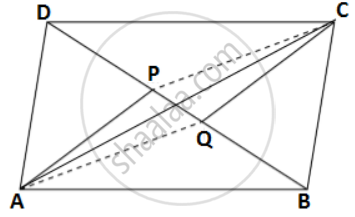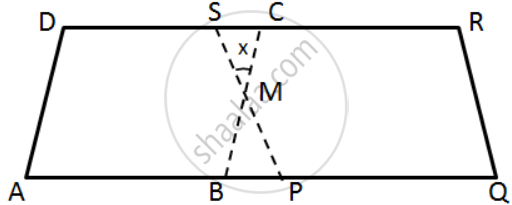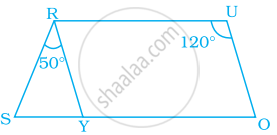Advertisements
Advertisements
Question
In the given figure, AP is the bisector of ∠A and CQ is the bisector of ∠C of parallelogram ABCD. 
Prove that APCQ is a parallelogram.
Solution
Construction: Join AC
Proof:
∠BAP =
∠DCQ =
⇒ ∠BAP = ∠DCQ ....(i)....[ ∠A = ∠R ( Opposite angles of a parallelogram.) ]
Now,
∠BAC = ∠DCA ....(ii)....[ Alternate angles since AB || DC ]
Subtracting (ii) from (i), We get
∠BAP - ∠BAC = ∠DCQ - ∠DCA
⇒ ∠CAP = ∠ACQ
⇒ AP || QC .....( Alternate angles are equal )
Similarly, PC || AQ.
Hence, APCQ is a parallelogram.
APPEARS IN
RELATED QUESTIONS
In a parallelogram
In the following figure, ABCD and PQRS are two parallelograms such that ∠D = 120° and ∠Q = 70°.
Find the value of x.
In case of a parallelogram
prove that:
(i) The bisectors of any two adjacent angles intersect at 90o.
(ii) The bisectors of the opposite angles are parallel to each other.
In the following figures, find the remaining angles of the parallelogram
In the following figures, find the remaining angles of the parallelogram
In a parallelogram ABCD ∠C = 98°. Find ∠A and ∠B.
The consecutive angles of a parallelogram are in the ratio 3:6. Calculate the measures of all the angles of the parallelogram.
The angles of a triangle formed by 2 adjacent sides and a diagonal of a parallelogram are in the ratio 1 : 5 : 3. Calculate the measures of all the angles of the parallelogram.
Opposite angles of a quadrilateral ABCD are equal. If AB = 4 cm, determine CD.
In the given parallelogram YOUR, ∠RUO = 120° and OY is extended to point S such that ∠SRY = 50°. Find ∠YSR.

